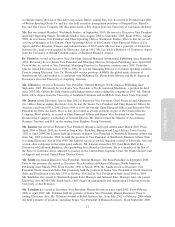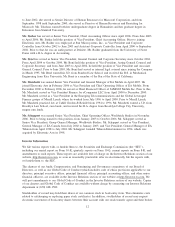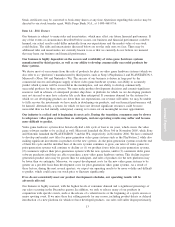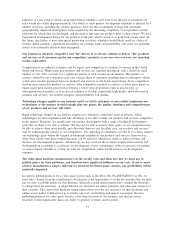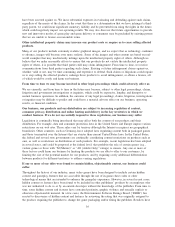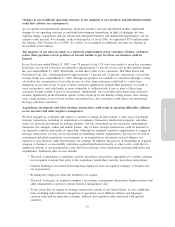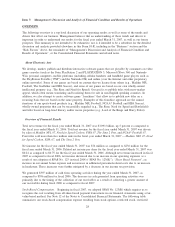Electronic Arts 2007 Annual Report Download - page 93
Download and view the complete annual report
Please find page 93 of the 2007 Electronic Arts annual report below. You can navigate through the pages in the report by either clicking on the pages listed below, or by using the keyword search tool below to find specific information within the annual report.
Changes in our worldwide operating structure or the adoption of new products and distribution models
could have adverse tax consequences.
As we expand our international operations, adopt new products and new distribution models, implement
changes to our operating structure or undertake intercompany transactions in light of changing tax laws,
expiring rulings, acquisitions and our current and anticipated business and operational requirements, our tax
expense could increase. For example, in the fourth quarter of fiscal 2006, we repatriated $375 million under
the America Jobs Creation Act of 2004. As a result, we recognized an additional one-time tax expense in
fiscal 2006 of $17 million.
The majority of our sales are made to a relatively small number of key customers. If these customers
reduce their purchases of our products or become unable to pay for them, our business could be
harmed.
In our fiscal year ended March 31, 2007, over 70 percent of our U.S. sales were made to seven key customers.
In Europe, our top ten customers accounted for approximately 31 percent of our sales in that territory during
the year ended March 31, 2007. Worldwide, we had direct sales to two customers, Wal-Mart Stores and
GameStop Corp., Inc., which represented approximately 13 percent and 12 percent, respectively, of total net
revenue in the year ended March 31, 2007. Though our products are available to consumers through a variety
of retailers, the concentration of our sales in one, or a few, large customers could lead to a short-term
disruption in our sales if one or more of these customers significantly reduced their purchases or ceased to
carry our products, and could make us more vulnerable to collection risk if one or more of these large
customers became unable to pay for our products. Additionally, our receivables from these large customers
increase significantly in the December quarter as they stock up for the holiday selling season. Also, having
such a large portion of our total net revenue concentrated in a few customers could reduce our negotiating
leverage with these customers.
Acquisitions, investments and other strategic transactions could result in operating difficulties, dilution
to our investors and other negative consequences.
We have engaged in, evaluated, and expect to continue to engage in and evaluate, a wide array of potential
strategic transactions, including (i) acquisitions of companies, businesses, intellectual properties, and other
assets, (ii) minority investments in strategic partners, and (iii) investments in new interactive entertainment
businesses (for example, online and mobile games). Any of these strategic transactions could be material to
our financial condition and results of operations. Although we regularly search for opportunities to engage in
strategic transactions, we may not be successful in identifying suitable opportunities. We may not be able to
consummate potential acquisitions or investments or an acquisition or investment may not enhance our
business or may decrease rather than increase our earnings. In addition, the process of integrating an acquired
company or business, or successfully exploiting acquired intellectual property or other assets, could divert a
significant amount of our management’s time and focus and may create unforeseen operating difficulties and
expenditures. Additional risks we face include:
• The need to implement or remediate controls, procedures and policies appropriate for a public company
in an acquired company that, prior to the acquisition, lacked these controls, procedures and policies,
• Cultural challenges associated with integrating employees from an acquired company or business into
our organization,
• Retaining key employees from the businesses we acquire,
• The need to integrate an acquired company’s accounting, management information, human resource and
other administrative systems to permit effective management, and
• To the extent that we engage in strategic transactions outside of the United States, we face additional
risks, including risks related to integration of operations across different cultures and languages,
currency risks and the particular economic, political and regulatory risks associated with specific
countries.
Annual Report
19




